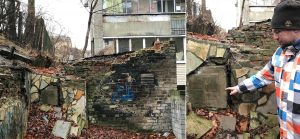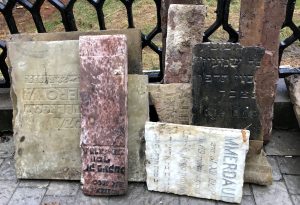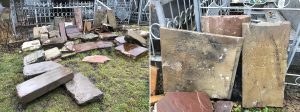Jay and I joined five volunteers from the Lviv Volunteer Center (LVC) working in a steady rain this week to recover more than 50 Jewish headstone fragments from a crumbling residential retaining wall in Lviv; the wall had been partially built from Jewish headstones, apparently during the post-war Soviet period. A single headstone visible in the wall after part of the facade had fallen away was brought to my attention via a Facebook message last week from a Ukrainian resident of the neighborhood. After a brief visit to the site over the weekend, it was clear that more volunteers and hand tools would be needed to extract not only the one stone which had been reported but also several other nearby headstone fragments spotted or suspected during that first visit.
![]() Ця стаття також доступна українською.
Ця стаття також доступна українською.
Located behind an abandoned historic building in Lviv, the retaining wall is only one block away from Barvinok Street, where in summer 2018 the LVC along with dozens of other volunteers, including Rohatyn Jewish Heritage plus church and university groups, extracted more than 125 large and intact Jewish headstones from under the road surface. Those headstones had been revealed during city road repairs, and while the road work was paused for more than five days to allow the headstone rescue and recovery operation, the volunteers lacked the necessary equipment to open the entire road and extract all of the headstones. Thus, the stones recovered last year represented perhaps only 20% of the total under the road, and many more still remain. Today the recovered headstones from this street work last year are at Lviv’s Yanivskiy new Jewish cemetery, and the LVC hopes to incorporate them in the future into a memorial wall at the site.

Volunteers from Ukraine, France, Germany, and America display examples of the newly-recovered headstone fragments. Photos © 2020 RJH.
In this week’s action, the volunteers first turned over large loose stone fragments stacked in front of the retaining wall, separating all of the stones with carved epitaphs in Hebrew or Polish and carrying them to a staging area. A few dozen cut and broken headstones were recovered from this stack and under rubble in adjacent areas, including a plaque made of marble and an unusual concrete matzevah fragment with raised molded Hebrew lettering. Then a crowbar was used to extract the original large headstone fragment from the retaining wall – revealing several other stones, also with visible epitaphs, embedded further behind. A few of those stones were removed using the crowbar, but several remain in the wall because they are affixed with mortar too strong for the hand tools we had with us. The LVC will arrange another recovery operation with hammers and chisels or power tools to extract the remaining headstones.
Following the extraction effort, the volunteers loaded the recovered headstone fragments into a rented van and transported them across town, stacking them adjacent to last year’s stones at the Yanivskiy new Jewish cemetery. Based on visible interwar dates on many of these headstone fragments, it is very likely that the recovered stones had originally been taken from this same cemetery during the German occupation of Lviv in WWII.
Several local journalists heard or read about this week’s rescue operation ahead of the work, and came to film and interview volunteers and residents, both at the retaining wall and in the cemetery; early news reports with video are already online.
We thank our friends at the LVC for organizing the volunteers and the transportation for the stones, and we were very pleased to support them in this ongoing work. The LVC has joined us several times to help clear wild vegetation in the new Jewish cemetery of Rohatyn during the last three years. They will return in late May 2020 to work with us again, this time at the old Jewish cemetery. All of this work, in Lviv and Rohatyn and elsewhere, requires constant attention and a readiness to respond to opportunities.




